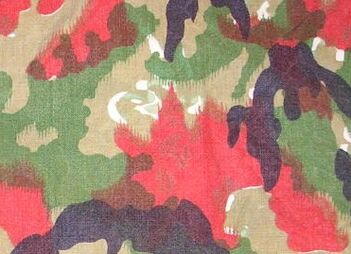
TAZ 57
First seen between 1955 and 1957, the Swiss Leibermuster pattern is modeled after the German WW2 Leibermuster camouflage design of the Waffen SS. Some sources suggest the Swiss obtained original German WW2 era roller-printing machines through Czechoslovakia, which is how they arrived at this particular camouflage pattern. The Swiss pattern appears in many guises and color combinations, particularly variations in the dominant background color. The original combat uniform in this pattern is designated the TAZ 57 (from the German Tarnanzug) or TASS 57 (from the French Tenue d'assaut), both meaning Combat Uniform (model) 1957. The first model (below, left) was made of lightweight canvas and featured a lighter coloration than the second model (below, right), fabricated from a heavier weight twill and reinforced in some places with waterproofed vinyl fabric. This design also appeared on zeltbahn (shelter halves,)panzerkombi (overalls for vehicle crews) and helmet covers. The early Swiss camouflage pattern is often called Alpentarn or Alpenflage by historians and collectors.